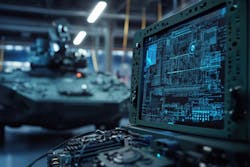Army to rely heavily on artificial intelligence (AI) in crew stations for next-gen armored combat vehicles
WARREN, Mich. – U.S. Army vetronics experts are approaching industry for artificial intelligence (AI)-based technologies for new crew stations aboard next-generation armored combat vehicles.
Officials of the Army Combat Capabilities Development Command, (DEVCOM) Ground Vehicle Systems Center (GVSC) in Warren, Mich., issued a request for information (GVSC_Advanced_crewstation_RFI_1) on Thursday for the Products and Services that would enable the development of Advance Crewstations for the US Army's Next Generation of Combat Vehicles project.
Army vetronics experts have identified several technical challenges where industry may have products and approaches for next-generation combat vehicle crew stations. This solicitation is part of the Army Crew Optimization and Augmentation Technologies (COAT) program.
Instead of taking an evolutionary approach of retrofitting today's combat vehicles with incremental technology upgrades, the Army is pursuing several all-new combat vehicle replacement acquisition programs, Army officials say.
Opportunity for new capabilities
This approach provides the opportunity for new capabilities in next-gen armored combat vehicles -- some of which that could see initial fielding within the next two years.
The Army is interested in enabling technologies for new ground combat vehicle crew stations that involve command and control and artificial intelligence (AI) assistants to help manage sensor data and ease vehicle crew member sensory and cognitive overload.
Technical challenges include optimal user interface for head- and helmet-mounted displays; soldier-guided adaptation for aided target recognition (AiDTR); voice-based AI assistants; embedded training; 3D and external audio; minimally intrusive real-time monitoring of crew health; automated visualization of work flows; autonomous simulation fidelity; human-autonomy teaming; virtual experimentation of emergent behavior; crew reduction enablers; optimal user interfaces; crew safety and protection systems; vehicle-mounted counter unmanned aircraft systems; vehicle-mounted docks for drones; and crew interfaces for drone control.
Optimal user interface for head- and helmet-mounted displays (HMD) involves a multi-modal user interface that enables the crew to interact with the graphical user interface in an intuitive, effective, and efficient ways for ground vehicle crews.
Soldier-guided adaptation for aided target recognition involves AI technology that identifies and tracks aerial and ground threats, to include personnel, across several color and thermal cameras in real-time while the vehicle is stationary or on-the-move.
Voice-based AI assistants would provide information on threats, execute voice commands, and automate tasks as needed to minimize crew workload and enhance overall crew situation awareness, lethality, and mobility.
Embedded training involves on-vehicle embedded software that enables immediate and on-demand individual training for vehicle drivers, commanders, and gunners; multi-member crew members working together; and interacting with off-vehicle training systems.
3D and external audio would enable crew members to hear auditory cues from outside the vehicle of potential threats approaching from land and air.
Crew health monitoring
Minimally intrusive real-time monitoring of crew health involves crew-wearable sensors for real-time monitoring of stress, cognitive workload, mental fatigue, and distraction.
Automated visualization of work flows would convert solid models, like a step, into a controllable object, like a drivable vehicle, within a simulation and training tool.
Autonomous simulation fidelity involves autonomy architectures for enabling sub-real-time and super-real-time simulation in hard-real-time control systems
Human-autonomy teaming involves intent-based direction; improved human interaction and interface technology of robots; and new ways to present several unmanned ground vehicles to the crew.
Virtual experimentation of emergent behavior seeks to develop data analysis methods of increasing fidelity to large-scale combat simulations; data visualizations to enable greater understanding of trends and ground-breaking behaviors; and supervised AI and machine-learning models to analyze vehicle types and capabilities for building predictive models.
Crew reduction enablers involve ways to mitigate the effects of crew reduction, such as reconfigurable control stations, as well as workload-balancing and task-redistribution algorithms.
Optimal user interfaces involves finding the best ways of communicating graphically, such as text, icons, shapes, light indicators, color indicators, sound, and voice to convey critical information.
Crew safety and protection systems involves fire suppression, air bags, rollover mitigation, and mine blast-protected seats, seating position, and footrests.
Counter unmanned aircraft
Vehicle-mounted counter unmanned aircraft systems involves the ability to detect and defeat at least small commercial and military drones, 360 degrees around the vehicle.
Vehicle-mounted docks for drones involves automated capability to store, recharge, swap-batteries, launch, and retrieve the Red Cat Holdings Teal Black Widow small uncrewed aircraft. At a minimum, it will store one drone, but ideally should be scalable to store several drones for swarms.
Crew interfaces for drone control involves either integrating existing drone controls or developing a new standard drone-control user interface based on the Robotic Autonomous Systems for Air (RAS-A) Interoperability Profile (IOP) standards for controlling several drones from the ground vehicle crew station.
Companies interested should email responses and questions no later than 8 June 2025 to the Army's Ben Berati at [email protected]. More information is online at https://sam.gov/opp/94973684dced4feba730a03e249a3e5e/view.
About the Author
John Keller
Editor-in-Chief
John Keller is the Editor-in-Chief, Military & Aerospace Electronics Magazine--provides extensive coverage and analysis of enabling electronics and optoelectronic technologies in military, space and commercial aviation applications. John has been a member of the Military & Aerospace Electronics staff since 1989 and chief editor since 1995.

